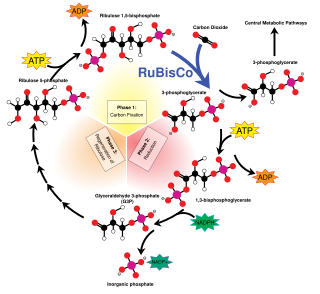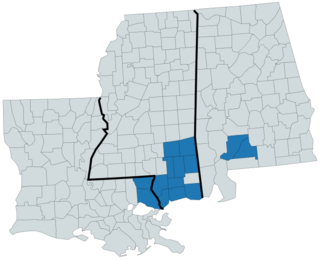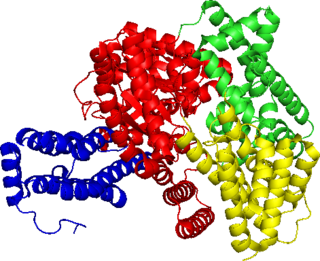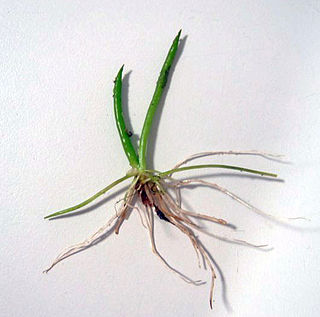
Photosynthesis is a system of biological processes by which photosynthetic organisms, such as most plants, algae, and cyanobacteria, convert light energy, typically from sunlight, into the chemical energy necessary to fuel their activities. Photosynthetic organisms use intracellular organic compounds to store the chemical energy they produce in photosynthesis within organic compounds like sugars, glycogen, cellulose and starches. Photosynthesis is usually used to refer to oxygenic photosynthesis, a process that produces oxygen. To use this stored chemical energy, the organisms' cells metabolize the organic compounds through another process called cellular respiration. Photosynthesis plays a critical role in producing and maintaining the oxygen content of the Earth's atmosphere, and it supplies most of the biological energy necessary for complex life on Earth.

Isoetes, commonly known as the quillworts, is a genus of lycopod. It is the only living genus in the family Isoetaceae and order Isoetales. There are currently 192 recognized species, with a cosmopolitan distribution mostly in aquatic habitats but with the individual species often scarce to rare. Some botanists split the genus, separating two South American species into the genus Stylites, although molecular data place these species among other species of Isoetes, so that Stylites does not warrant taxonomic recognition. Species virtually identical to modern quillworts have existed since the Jurassic epoch, though the timing of the origin of modern Isoetes is subject to considerable uncertainty.

Crassulacean acid metabolism, also known as CAM photosynthesis, is a carbon fixation pathway that evolved in some plants as an adaptation to arid conditions that allows a plant to photosynthesize during the day, but only exchange gases at night. In a plant using full CAM, the stomata in the leaves remain shut during the day to reduce evapotranspiration, but they open at night to collect carbon dioxide and allow it to diffuse into the mesophyll cells. The CO2 is stored as four-carbon malic acid in vacuoles at night, and then in the daytime, the malate is transported to chloroplasts where it is converted back to CO2, which is then used during photosynthesis. The pre-collected CO2 is concentrated around the enzyme RuBisCO, increasing photosynthetic efficiency. This mechanism of acid metabolism was first discovered in plants of the family Crassulaceae.

C4 carbon fixation or the Hatch–Slack pathway is one of three known photosynthetic processes of carbon fixation in plants. It owes the names to the 1960s discovery by Marshall Davidson Hatch and Charles Roger Slack.

C3 carbon fixation is the most common of three metabolic pathways for carbon fixation in photosynthesis, the other two being C4 and CAM. This process converts carbon dioxide and ribulose bisphosphate (RuBP, a 5-carbon sugar) into two molecules of 3-phosphoglycerate through the following reaction:

Vernal pools, also called vernal ponds or ephemeral pools, are seasonal pools of water that provide habitat for distinctive plants and animals. They are considered to be a distinctive type of wetland usually devoid of fish, and thus allow the safe development of natal amphibian and insect species unable to withstand competition or predation by fish. Certain tropical fish lineages have however adapted to this habitat specifically.

Isoetes louisianensis, the Louisiana quillwort, is a small, grass-like aquatic plant of the family Isoetaceae. It is "one of the rarest quillworts in North America." It occurs in only five locations in St. Tammany and Washington Parishes of Louisiana, as well as some spots in southern Mississippi and south-central Alabama. It is federally listed as an endangered species, partly due to its highly restricted range.

Isoetes lacustris, the lake quillwort or Merlin's grass, is a boreal quillwort native on both sides of the northern Atlantic Ocean. Synonyms include Isoetes hieroglyphica.

Isoetales, sometimes also written Isoëtales, is an order of plants in the class Lycopodiopsida.

Phosphoenolpyruvate carboxylase (also known as PEP carboxylase, PEPCase, or PEPC; EC 4.1.1.31, PDB ID: 3ZGE) is an enzyme in the family of carboxy-lyases found in plants and some bacteria that catalyzes the addition of bicarbonate (HCO3−) to phosphoenolpyruvate (PEP) to form the four-carbon compound oxaloacetate and inorganic phosphate:
Pleuromeia is an extinct genus of lycophytes related to modern quillworts (Isoetes). Pleuromeia dominated vegetation during the Early Triassic all over Eurasia and elsewhere, in the aftermath of the Permian–Triassic extinction event. During this period it often occurred in monospecific assemblages. Its sedimentary context in monospecific assemblages on immature paleosols, is evidence that it was an opportunistic pioneer plant that grew on mineral soils with little competition. It spread to high latitudes with greenhouse climatic conditions.
Isoetes sinensis, the narrow quillwort, is a species of plant in the family Isoetaceae.

Isoetes bolanderi, or Bolander's quillwort, is a species of quillwort, a type of lycophyte. This aquatic plant is native to high altitude regions of the western United States and southern Alberta. It grows almost entirely underwater in lakes and other water bodies from a corm-like stem, which remains buried in the mud, producing up to twenty pointed, cylindrical leaves approaching 15 centimeters in maximum length. It reproduces via spherical sporangia, covered about one third by the velum. The ligule is small and heart-shaped. The megaspores are white, though sometimes bluish, and 350 to 290 micrometers in diameter. The microspores are 25 to 30 micrometers long.
Isoetes eludens is an aquatic plant in the genus commonly known as quillwort that is native to the Kamiesberg Mountains in Namaqualand, South Africa. So far it is known to grow only in a single !gau (gnamma), a small temporary pool formed in a hollowed out area of granite rock. It has likely been growing in that region for millions of years, but was only discovered in 2007 and described in 2009. The specific epithet eludens refers to the fact that it eluded discovery, in spite of several searches in recent years in the area for new quillwort species.
The evolution of photosynthesis refers to the origin and subsequent evolution of photosynthesis, the process by which light energy is used to assemble sugars from carbon dioxide and a hydrogen and electron source such as water. It is believed that the pigments used for photosynthesis initially were used for protection from the harmful effects of light, particularly ultraviolet light. The process of photosynthesis was discovered by Jan Ingenhousz, a Dutch-born British physician and scientist, first publishing about it in 1779.
Isoetes toximontana, the Gifberg quillwort, is a plant species native to the Northern Cape and Western Cape regions of South Africa. It is known from only 3 sites. The type locality is on the slopes of Gifberg, a mountain forming part of the eastern boundary of the Olifants River Valley. The name "Gifberg" means "poison mountain"; this is in reference to a poisonous tree called "gifboom", Euphorbia virosa, that is endemic to the area. The specific epithet "toximontana" is a Latin translation of the Afrikaans name of the mountain.

Isoetes echinospora, also known as spiny quillwort, spiny-spored quillwort or spring quillwort is a species of quillwort in the Isoetaceae family, and is the most abundant species in Canada. It can be found in shallow aquatic environments from Labrador and Newfoundland to Alaska, and south to Pennsylvania, Wisconsin, Michigan, Colorado, and California. In Germany it is found in only two locations: the Feldsee and Lake Titisee, both in the High Black Forest.

Isoetes butleri, commonly known as limestone quillwort, is a species of plant in the quillwort family, a member of the lycophytes.

Littorella uniflora (vernacular name: (American) shoreweed) is a species of aquatic flowering plant native to the Azores, Morocco, most of Europe excluding the dry southeast, Iceland, and the Faroes. It prefers to live mostly submerged in nutrient-poor freshwater habitats. When submerged, it draws CO2 mostly through its roots and uses a mix of crassulacean acid metabolism (CAM) and C3 carbon fixation for photosynthesis. If the water level drops and exposes the roots, it ceases using CAM.
Isoetes stellenbossiensis, the Stellenbosch quillwort or Cape Flats quillwort, is a species of plant from South Africa.














